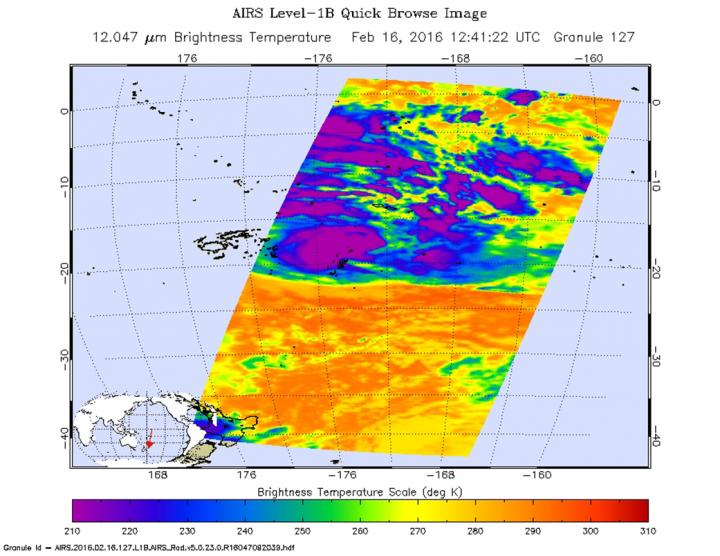NASA sees Tropical Cyclone Winston threatening Tonga and American Samoa

On Feb. 16 the AIRS instrument aboard NASA's Aqua satellite saw cloud top temperatures in strong thunderstorms exceeding -63F/-53C (purple) around the center of circulation. Credits: NASA JPL, Ed Olsen
On Feb.16 a gale warning was in effect for Niue. In Tonga, a storm warning was in effect for Vavau and a gale warning was in effect for Ha'apai, Niuafo'ou and Niuatoputapu.
On Feb. 16 at 1500 UTC (10 a.m. EST) Tropical cyclone Winston's maximum sustained winds had increased to hurricane-force after spending several days as a tropical storm. Winds were near 65 knots (74.8 mph/120.4 kph). Winston was centered near 17.9 degrees south latitude and 173.6 degrees west longitude, about 273 nautical miles (314 miles/505 km) southwest of Pago Pago, American Samoa. Winston was moving to the northeast at 10 knots (11.5 mph/18.5 kph).
On Feb. 16 the Atmospheric Infrared Sounder (AIRS) instrument aboard Aqua saw cloud top temperatures exceeding -63 degrees Fahrenheit (-53 degrees Celsius) around the 23 nautical-mile wide eye. Storms with cloud tops that cold are very high into the troposphere and have the capability of producing heavy rainfall.
The Joint Typhoon Warning Center noted “Winston is currently positioned in a good environment for intensification with favorable sea surface temperatures and low vertical wind shear.
JTWC expects Winston to move northeast and start to re-strengthen. The storm is forecast to peak at 100 knots (115.1 mph/185.2 kph) by Feb. 17 and 18, south of American Samoa, before turning back west.
Media Contact
All latest news from the category: Earth Sciences
Earth Sciences (also referred to as Geosciences), which deals with basic issues surrounding our planet, plays a vital role in the area of energy and raw materials supply.
Earth Sciences comprises subjects such as geology, geography, geological informatics, paleontology, mineralogy, petrography, crystallography, geophysics, geodesy, glaciology, cartography, photogrammetry, meteorology and seismology, early-warning systems, earthquake research and polar research.
Newest articles

Superradiant atoms could push the boundaries of how precisely time can be measured
Superradiant atoms can help us measure time more precisely than ever. In a new study, researchers from the University of Copenhagen present a new method for measuring the time interval,…

Ion thermoelectric conversion devices for near room temperature
The electrode sheet of the thermoelectric device consists of ionic hydrogel, which is sandwiched between the electrodes to form, and the Prussian blue on the electrode undergoes a redox reaction…

Zap Energy achieves 37-million-degree temperatures in a compact device
New publication reports record electron temperatures for a small-scale, sheared-flow-stabilized Z-pinch fusion device. In the nine decades since humans first produced fusion reactions, only a few fusion technologies have demonstrated…





















